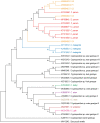A survey of Cryptosporidium prevalence among birds in two zoos in China
- PMID: 35111415
- PMCID: PMC8783555
- DOI: 10.7717/peerj.12825
A survey of Cryptosporidium prevalence among birds in two zoos in China
Abstract
Background: Cryptosporidiosis is an important zoonotic protozoan disease worldwide, but few studies on this disease have been performed in wild birds; thus, our knowledge of this disease is insufficient, even in zoo birds. Animals in zoos are possible zoonotic disease reservoirs, potentially resulting in zoonotic agent spillover to humans; accordingly, our understanding of such phenomena should be improved.
Methods: A total of 263 fresh fecal samples from 43 avian species were randomly collected from the Beijing Zoo and Harbin North Forest Zoo and screened for the prevalence of Cryptosporidium by 18S rRNA gene sequencing. Cryptosporidium species were distinguished based on the combined results of phylogenetic tree and genetic distance analyses conducted with the inclusion of seven avian Cryptosporidium species and 13 avian Cryptosporidium genotypes. The genetic diversity of Cryptosporidium parvum among different hosts, including humans, cattle, dogs, and birds, and the genetic diversity of avian C. parvum among avian hosts in China, Iraq and Brazil were determined based on C. parvum 18S rRNA haplotypes.
Results: The results of PCR targeting the 18S rRNA gene revealed that 1.9% (5/263) of the samples were Cryptosporidium-positive. Four of the five Cryptosporidium-positive samples originated from white cranes (Grus leucogeranus), and one originated from a flamingo (Phoenicopteridae). Avian C. parvum isolates, including the isolates examined in the present study, showed gene flow with other isolates from different types of hosts, including humans, cattle and dogs, indicating that zoo birds potentially pose zoonotic and pathogenic risks to humans and animals. Additionally, gene flow between avian C. parvum isolates from China and Brazil was detected.
Conclusions: To the best of our knowledge, our results demonstrate C. parvum infection in a flamingo (Phoenicopteridae) and white cranes (Grus leucogeranus) for the first time. The results of our study provide an important reference for understanding the host range, biological characteristics, and molecular epidemiology of C. parvum.
Keywords: 18S rRNA gene; Cryptosporidium parvum; Flamingo (Phoenicopteridae); Phylogenetic; White crane (Grus leucogeranus).
©2022 Lu et al.
Conflict of interest statement
The authors declare there are no competing interests.
Figures


References
-
- Azmanis P, diSomma A, Pappalardo L, Silvanose CD, Bangoura B. First detection of Cryptosporidium parvum in falcons (Falconiformes): diagnosis, molecular sequencing, therapeutic trial and epidemiological assessment of a possible emerging disease in captive falcons. Veterinary Parasitology. 2018;252:167–172. doi: 10.1016/j.vetpar.2018.02.012. - DOI - PubMed
Publication types
MeSH terms
Substances
LinkOut - more resources
Full Text Sources
Medical

